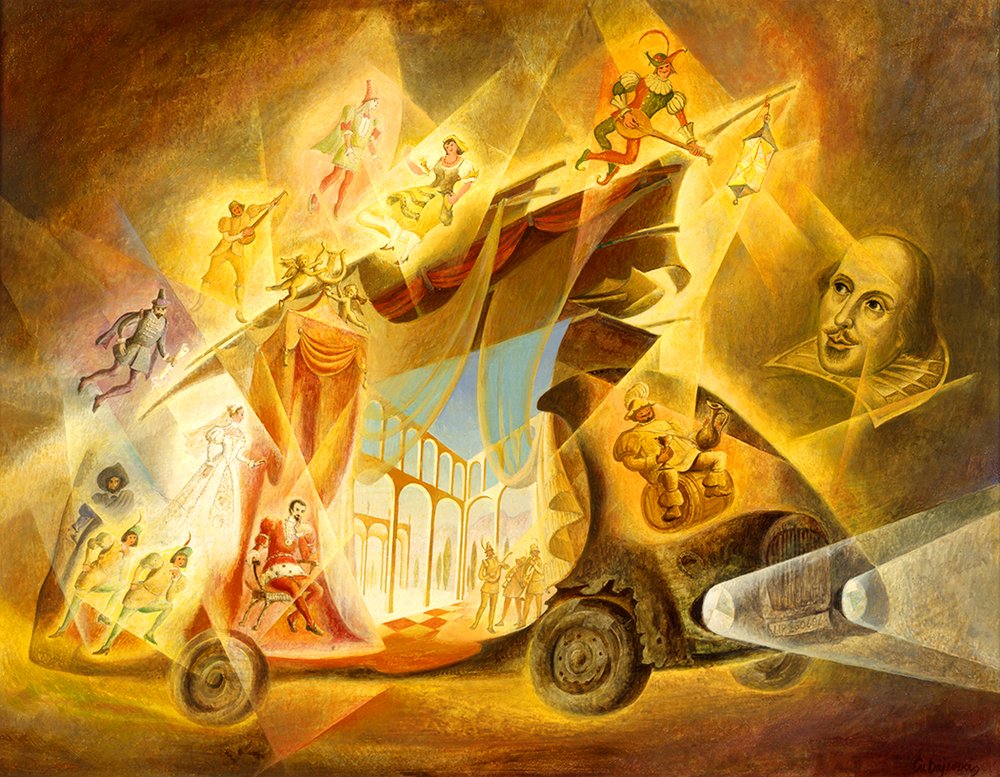Stop 19

The Dreadnought; Travels with Shakespeare, Germany. | Drednauts; Ceļojumi ar Šekspīru, Vācijā.
Acrylic on masonite | Akrils uz mesonīta, 27.75 in x 36.5 in (70.49 cm x 92.71 cm), 1977.
In the fall of 1945, soon after joining the Latvian Theater Company of Meerbeck as its set designer, my father retrofitted a six-ton Renault truck into a cargo vehicle for the theater. Once used by the British Army Red Cross, the truck now hauled the repertory company’s modular stage, scenery, costumes, props—and entire cast. For six years it traveled across western Germany to displaced persons (DP) camps scattered throughout the British and American zones of Allied occupation. The vehicle was christened the “Dreadnought.” Naming the truck after the invincible class of British Navy destroyers of the First World War was a powerful metaphor. Those vessels played a central role in stopping the German military machine, finally ending that war. Now a different kind of dreadnought was needed to fight, not in a theater of war, but in the actual theater, for the spiritual well-being and sustenance of Latvian refugees. In this case, the action occurred on the floorboards of a new traveling repertory company dedicated to bringing some entertainment to the Latvian refugee audiences that were stranded in the dreary DP camps. In this painting, my father pays tribute to the company of players that performed in the company’s production of Shakespeare’s Twelfth Night. My father’s colleagues appear spotlighted within the silhouette of the beloved “Dreadnought.” William Shakespeare looks on admiringly.
In His Own Words:
Significance of the "Dreadnought" (Stop 19)
“My first assignment for the traveling theater was to design a modular theater stage that could go wherever we went, without having to improvise or adjust to unforeseen conditions. A traveling theater company needs to be self-sufficient. To achieve this goal, the acquisition of a six-ton Renault truck was critical. I was responsible for retrofitting it to meet the requirements of a traveling theater. It included seating for the entire cast.
This truck became one of the cornerstones of the theater. While many plays were produced and staged in the city of Meerbeck, the Latvian Theater became much awaited at refugee camps. It was rewarding for all members of the company to have a common goal: to put on performances. This gave us the creative sustenance to go on and to produce new shows.”
Viņa
paša vārdos:
„Drednautaˮ nozīme (19. pietura)
„Mans pirmais uzdevums bija, izveidot ceļojoša teātra skatuvi tā, lai katrā citā vietā nebūtu jāimprovizē un jāpiemērojas katras vietas neparedzētiem apstākļiem. Arī ceļojošam teātrim bija jāpastāv kā veselai un nesakropļotai mākslinieciskai vienībai. Šīs iespējas realizēšanai ļoti palīdzēja iegūtas seštonnīgas “Reno” [Renault] automašīnas piemērošana teātra ceļošanai. Šī mašīna bija viens no teātra “stūrakmeņiem.” Mērbekā radās daudzas izrādes un inscinējumi. Mērbekas teātris bija gaidīts viesis visās nometnēs. Tas arī bija gandarījums visiem darba darītājiem un deva spēku nākošiem uzdevumiem.”